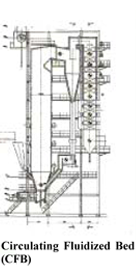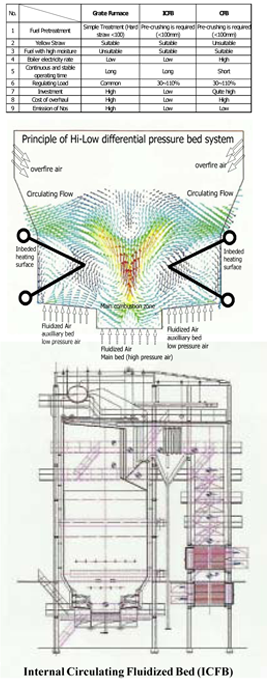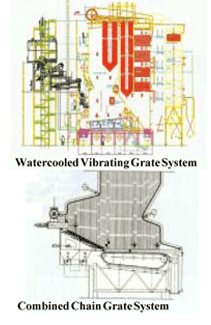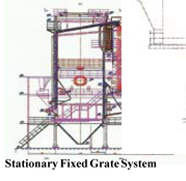Hi-Low Bed ICFB
BEST SELECTION FOR BIOMASS AND LOW CALORIE COAL |
Four Important Elements that Affect Deposit
K (Na)
Oxide, chloride and sulfate are formed by the vaporization and decomposition of potassium (K). All these compounds have low fusion points. When the K and its compound congealed on the flying ash particles, the surface of flying ash particle will contains K. Thus, the par- ticles will be stickier and have low fusion point.
Cl
Cl has a kind of transmission function during the biomass combustion. This will help the alkali metal elements move to the particle surface from the inner part of fuel particle to have chemical reaction with other substances. At the same time, it will facilitate the vapor- izationofalkalimetalelements.
S
After vaporization, S has chemical reaction with alkali metal of gaseous phase and generatesalkalimetalsulphide. Moreover, they congeal with each other on the ash particles or deposit of water wall to form a white thin layer for fa- cilitatingthegatheringandbond of deposit.
Ca
When biomass is rich in K, Ca and S,the soot deposit and slag-bonding will be serious. The clinkering in fluidized bed mainly occurs during the sul- phating process of CaO and among the particles of CaSO4. Fusion phase appears obvi- ouslyamongtheclinkeringpar- ticles. CaSO4 is regarded as binding agent of ash particles on the surface of superheater tube, which can make the soot deposit and slag-bonding more serious.
|
 |
|
Characteristics of biomass fuel
Physical and Chemical characteristics of Biomass:
1.Low ash content.
The ash content of wooden raw materials is extremely low, which is only 1-3%. While the straw is higher, which is 5-10%.
2.Looseness of texture, low density.
The nature bulk density of biomass fuel is generally around 50-200kg/m3.
3.Alkalis metal content, such as K and Na
Is high. Meanwhile, it contents certain amount of Cl-. Therefore, the ash melting point is low and it is corrosive.
|
 |
4.Low Sulfur content,
Generally less than 0.3%.
5.High volatile. V olatile of dry ash-free basis is gener- ally more than 60%.
Merits of ICFB in terms of biomass fuels:
ICFB can resolve the existing problem of biomass fuels combustion. The following table is a comparison for the type and performance between ICFB and CFB:
|
 |
|
Merits of High-low Internal Circulating Fluidized Bed (ICFB):
Burning biomass with ICFB has the following key advantages:
1.By using the heating surface of dense zone, it is easy to control the temperature of dense zone in a range of 700-800 oC which will resolve the coking problem of the bed fuel.
2.Controlling the furnace temperature in a range of 750-800 oC by adopting large furnace section, much bigger than the normal CFBC.
3.Large furnace section, low gas velocity will result less consumption of bed materials. For normal 75t/h CFB, the amount of bed material sand should be compensated about 2 ton per hour, while ICFB fluidized bed only needs about 30kg per hour.(Silica sand)
4.The pressure head of air blower is lower than normal CFB, so its power consumption is much less. The separator will be installed in the system, however, with this low factor circulating, the separator resistance is far below than normal CFB. This will reduce the resistanceof boiler proper and reduce the power consumption of IDF.
5.ICFB will have less ash built up in the furnace which will lower the corrosion factor which means longer lifespan of boiler and less maintenance workmanship.
6.Air is supplied ICFB with grade controller. This will control the discharge of NOx.
Various type of Biomass Boiler
kind of combustion:
1.Stationary Fixed Grate
2.Water-cooled vibrating Grate 3.Combined
Chain grate Fluidized bed:
1.Bubbling Fluidized bed (BFB) 2.Normal Fluidized bed (CFB)
3.High-low internal circulating fluidized bed (ICFB)
|
 |
|
Adopting the technology of ICFB.
Its main point is to change the single fluidized bed of normal FBC by using multi-layer bed and the so called differ- ential velocity fluidized bed structure with different fluidized air velocity. Compar- ing with FBC boiler of single fluidized bed, it has characteristics as follows: 1.Fuels can be separated by different grain sizes, the coarse particles are con- centrated on the lower layer of main bed, and fine particles are on upper layer of auxiliary bed. Since the separated aver- age grain size of fuels on auxiliary bed is smaller than the main bed, the fluidized air velocity of auxiliary bed is 1-1.5 twice lower than main bed's. Fine fuels and low fluidized air velocity can significantly re- duce the wear of heating surface of sub- merged pipe (the pipe lifespan can in- crease to 30,000 hours from the general 5,000 hours), which solves the problem of safe reliability of CFB boiler. 2.Internal circulation of fuels that formed by different fluidized air velocity between high and low bed which strengthens the horizontal intense mix of the fuels extends the staying time of fuels and desulfurizing agent in the bed this enhances the com- bustion efficiency and desulfurizing rate of boiler. This technology is especially suitable for burning mixed fuel.
3.ICFB boiler will have better load regu- lating performance with multi-layer bed structure. Particularly, it has improved the phenomenon of coking and lowers the surplus in the flow gas. With this technology, the boiler can also operate economically and reliably under load of about 30%
4.Since fuels are mainly fed to the main bed and the air volume is blown into the main and auxiliary bed respectively, the formed NOX is highly reduced.
5.With the function of different air veloc- ity for main and auxiliary bed, we can realize a kind of convenient combustion with mixing coal and biomass which are different in density. ICFB boiler can burn fuel in the main and auxiliary bed respec- tively which is different from normal CFB boiler.
|
 |
|
|